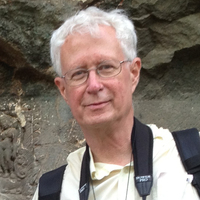
Fani Gargova
Related Authors
Deborah Klimburg-Salter
University of Vienna
Marion Meyer
University of Vienna
Tolga B. Uyar
Nevsehir Haci Bektas Veli University
Nilüfer Peker
Nevsehir Haci Bektas Veli University
Anna Tsypkina
Institute of World History, Russian Academy of Sciences
Galina Fingarova
University of Vienna
Sashka Bogevska-Capuano
Centre National de la Recherche Scientifique / French National Centre for Scientific Research
Eirini Panou
University of Cyprus
Robert S Nelson
Yale University
InterestsView All (62)










Uploads
Papers by Fani Gargova
Talks by Fani Gargova
Die sephardisch-jüdische Bevölkerung von Sofia nimmt in diesem Prozess eine zentrale Rolle ein. So wurde während der Urbanisierung nach zentraleuropäischem Vorbild der jüdischen Bevölkerung ein eigenes, im orthogonalen Muster neu erbautes Viertel, „Ütschbünar“, zugewiesen. In der Mitte dieses auf dem Reissbrett entworfenen Stadtteils, welcher in seinem Raumverständnis grundlegend vom osmanischen abweicht, wurde jedoch eine Kirche und keine Synagoge erbaut. Die Synagoge wurde zeitgleich am zentralen Marktplatz von Sofia errichtet und fungierte somit als ein bedeutender Ort für die Verhandlung nicht nur der jüdischen Identität, sondern auch jener der bulgarischen Gesellschaft der Hauptstadt im Allgemeinen. In diesem Vortrag soll ein fundiertes Verständnis des postosmanischen Balkanraumes und des „shared space“ aufgezeigt werden, welcher ein Zusammenleben von diversen ethnischen und religiösen Gruppen ermöglichte. Zur Zeit der Erbauung der Synagoge von Sofia mussten die Grundlagen des Zusammenlebens erst innerhalb des rationalisierten und kontrollierten westeuropäischen Raumverständnisses definiert werden.
Bulgaria’s independence from Ottoman rule in 1878 created a fundamental need for self-definition and a proud identity that can be traced back to a previous grandeur, a period of national confidence that existed before submission to a foreign empire. This nation-building movement was an important part of a development towards Europeanization and modernization and the effort to catch up on similar ideological foundations throughout the 19th century in Western and Central Europe. It also produced a romanticized view of the First and Second Bulgarian Kingdoms of the Middle Ages that were historically stylized as the great enemies of the Byzantine Empire.
A search for the material manifestations of these strong, important states led in the period around 1900 to the discovery of Pliska and Preslav, the first two capitals of the First Bulgarian Kingdom, among others and the commencement of building activity in a Bulgarian style, such as the 1890s construction of the Sveta Nedelya cathedral. The expansionary agenda of the Bulgarian king Ferdinand I. during the Balkan Wars and the First World War gave archaeologists and historians like Bogdan Filov the possibility to travel and discover an extensive Bulgarian territory that would also encompass the Macedonian and Thracian landscapes. This broader understanding of the medieval Bulgarian legacy formed the scholarship after the First World War in a considerably nationalistic way. The buildings of the time – such as the Court House and the new Sveta Nedelya church in Sofia – testify to a well-informed conception of Bulgarian and Byzantine art and architecture and are specifically monumental in their appearance.
In this paper I examine the specific agenda of studying a Bulgarian medieval artistic past during the indicated period. Of special interest are the modes of transmission of a national idea and the historical approaches, which underpin their validity. I contrast this scholarship with the buildings that were realized during the same period and ask whether and how they support these mindsets.
Die sephardisch-jüdische Bevölkerung von Sofia nimmt in diesem Prozess eine zentrale Rolle ein. So wurde während der Urbanisierung nach zentraleuropäischem Vorbild der jüdischen Bevölkerung ein eigenes, im orthogonalen Muster neu erbautes Viertel, „Ütschbünar“, zugewiesen. In der Mitte dieses auf dem Reissbrett entworfenen Stadtteils, welcher in seinem Raumverständnis grundlegend vom osmanischen abweicht, wurde jedoch eine Kirche und keine Synagoge erbaut. Die Synagoge wurde zeitgleich am zentralen Marktplatz von Sofia errichtet und fungierte somit als ein bedeutender Ort für die Verhandlung nicht nur der jüdischen Identität, sondern auch jener der bulgarischen Gesellschaft der Hauptstadt im Allgemeinen. In diesem Vortrag soll ein fundiertes Verständnis des postosmanischen Balkanraumes und des „shared space“ aufgezeigt werden, welcher ein Zusammenleben von diversen ethnischen und religiösen Gruppen ermöglichte. Zur Zeit der Erbauung der Synagoge von Sofia mussten die Grundlagen des Zusammenlebens erst innerhalb des rationalisierten und kontrollierten westeuropäischen Raumverständnisses definiert werden.
Bulgaria’s independence from Ottoman rule in 1878 created a fundamental need for self-definition and a proud identity that can be traced back to a previous grandeur, a period of national confidence that existed before submission to a foreign empire. This nation-building movement was an important part of a development towards Europeanization and modernization and the effort to catch up on similar ideological foundations throughout the 19th century in Western and Central Europe. It also produced a romanticized view of the First and Second Bulgarian Kingdoms of the Middle Ages that were historically stylized as the great enemies of the Byzantine Empire.
A search for the material manifestations of these strong, important states led in the period around 1900 to the discovery of Pliska and Preslav, the first two capitals of the First Bulgarian Kingdom, among others and the commencement of building activity in a Bulgarian style, such as the 1890s construction of the Sveta Nedelya cathedral. The expansionary agenda of the Bulgarian king Ferdinand I. during the Balkan Wars and the First World War gave archaeologists and historians like Bogdan Filov the possibility to travel and discover an extensive Bulgarian territory that would also encompass the Macedonian and Thracian landscapes. This broader understanding of the medieval Bulgarian legacy formed the scholarship after the First World War in a considerably nationalistic way. The buildings of the time – such as the Court House and the new Sveta Nedelya church in Sofia – testify to a well-informed conception of Bulgarian and Byzantine art and architecture and are specifically monumental in their appearance.
In this paper I examine the specific agenda of studying a Bulgarian medieval artistic past during the indicated period. Of special interest are the modes of transmission of a national idea and the historical approaches, which underpin their validity. I contrast this scholarship with the buildings that were realized during the same period and ask whether and how they support these mindsets.
As a case study, this panel discussion aims to introduce ICFA's leading protagonist Thomas Whittemore and the unique collection of moving images by the Byzantine Institute, a non-profit organization established in 1930 by Whittemore to document their fieldwork activities, including restoration and conservation. To understand the Institute's mission, we need to examine the stylistic differences between its first film documentation of the Red Sea Monasteries in Egypt, filmed in black-and-white, and the two most important monuments of Byzantine culture, Hagia Sophia and Kariye Camii in Istanbul, Turkey. The former illustrates a traditional style of film documentation for archaeological excavations with an anthropological interest, while the latter, filmed in color as early as 1936 to 1948, displays a more formal and intimate approach towards the monuments. They were instrumental for the promotion of the Institute's goal to capture the quality and splendor of Byzantine mosaics and also illustrate the early techniques of restoration and conservation, leaving an indispensable document of the methods employed.
Our questions for this panel discussion include: What were the initial motivations to use moving images in the documentation of fieldwork activities? Was it solely a financial matter or can moving images of fieldwork projects transmit a different message than still photography? Are the decisions (e.g., color film vs. black-and-white film) dependent on the subject being captured or are they based on the cinematographer's vision? And finally, what role did the films play for the reception of Medieval and Byzantine art?
culture and came to call it their own. This panel will not merely present manifestations of those processes after the establishment of modern nation states in the 19th century, but will explore the relationships between ideology and material culture throughout three subsequent political structures – royal, communist, and democratic – in those areas up to today. It will investigate the different and specific vernacular conceptions of the Middle Ages at the “margins” of Europe.
In conjunction with the 2015 Byzantine Studies Symposium at Dumbarton Oaks, this exhibition highlights drawings by Paul Underwood, which resulted from a project to reconstruct the lost church of the Holy Apostles in Constantinople.
The electronic version of this book – https://books.openedition.org/efr/18397 – contains the complete proceedings of the conference, including the numerous abstracts of papers delivered in the various sessions. The printed version consists of the introduction, the bibliography, and the seven plenary lectures.